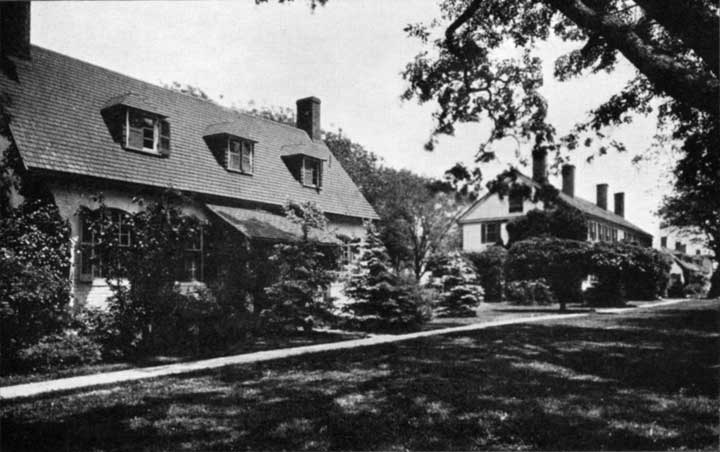| In Tidewater Virginia |
|
From "In Tidewater Virginia" by Dora Chinn Jett, Whittet & Shepperson, Richmond, Va. 1924 The book is a tour of old homes along the Rappahannock River, and the last chapter deals with Rosegill. Many thanks to Bill and Karen Carr for bringing this to our attention. |
Rosegill
“Rosegill, where the Wormeleys lived in English state, has passed from hand to hand, and is reduced to left than half its size.”
Bishop Meade
And now another old home, across the wide waters, is beckoning, and its reputed charm is too enticing to resist. This is Rosegill, in Middlesex County, built shortly after the middle of the seventeenth century by Colonel Ralph Wormeley, Secretary of the Colony of Virginia.
Crossing the broad river by way of Tappahannock Ferry, and again traversing many miles of the scenic Tidewater Trail, the little village of Urbanna is reached. Winterbotham says in his history of America, 1796, that Urbanna “has all the appearance of a deserted village.’’ Today it has all the appearance of a village, but the air of desertion is not there, and, with its extended and beautiful water front, its splendid commercial facilities, and other pronounced assets, it may yet, though the hour is late, blossom into a metropolis.
The often-repeated beauty of Rosegill raises one’s expectations beyond the usual level. But once on that commanding bluff, with the broad Rappahannock spread out before, with every item of the handsome grounds in pleasing symmetry, and with the message of the past of two centuries and a half still conveyed in the lines and the atmosphere of the charming old home, there is no trace of disappointment.
The vast possessions included in Rosegill, in the freshness of its youth, are graphically described in that delightful little sketch of life in Virginia in l656, written by a Frenchman (lately translated and annotated by Mr. Fairfax Harrison) who says: “He [Mr. Wormeley] has, too, at least twenty houses scattered along a charming plateau above the Rappahannock River. The best of these he had lent to the Governor [Sir Henry Chicheley, Deputy Governor]. Arriving thither, I might have believed myself to be entering a good-sized town, and I learned later that all of it belonged to Mr. Wormeley.’’

Owing to its many years, and the many changes in ownership, and consequent careless upkeep Rosegill had fallen into a sad state of dilapidation, when, in 1901, the late State Senator, J. H. Cochran, of Pennsylvania, purchased it for a home, restored the old house, as far as possible, to the original lines, and embellished the grounds with many rare trees, and much blossoming shrubbery. The house was originally of red brick, but in recent years a coat of stucco has been applied as far at the second floor.
A broad hall runs the entire length of the house on the river side. From the numerous windows therein, and from the broad dormer windows of the second story, the view of the landscape will not be soon forgotten. In the distance is spread the far-reaching waters, and the green of the grounds in the foreground, with avenues of beeches and poplars, and masses of roses and lilacs and iris, bordering the broad gravel paths, is indeed a joy. One of these paths leads from the mansion to the river’s brink, where embowered in fragrant vines, is the inviting summer house, and where sweet peas in luxuriant masses blossom on the bank.
So well was Rosegill equipped to dispense Mr. Cochran’s generous hospitality that he has entertained as many as forty friends at a time, it is said.
The yet broad estate of nearly seven hundred acres has recently passed into the ownership of Mr. and Mrs. Norwood Browning Smith, who plan other extensive improvements, and will plant many acres in cotton.
The old T-shaped red brick house, Hewick, the seventeenth-century home of Christopher Robinson, is not far away. He was a brother of John, Bishop of London, and was an important man in the colonies. He was one of the trustees of William and Mary College, and his influence and interest led him into many active fields of service.
Although its corner bricks reveal 16—, the structural part of the building is wonderfully preserved, it is owned by Mrs. Thomas G. Jones and tenanted.
One hopes that the near future holds in store another visit to these identical spots, and to others so regretfully passed, whose charm is also most alluring.
And the material current of the old Rappahannock hastens on, past the pretty little village of Irvington, past the wharves, Millenbeck, Weems, Bertrand and White Stone, past old Christ Church, with its ancient epitaphs in close proximity.
But the big heart of the river abides there still, and through its long length it overflows with fragrant memories of a picturesque and significant past, and definite messages from worthy grandsires are sent from yet existent homes on its banks,—homes whose gardens still breathe the breath of aromatic boxwood, the spicy redolence of old-time favorites, and of the friendly and tenacious English ivy and clematis.
Fulfilling its meritorious mission, the identity of its waters is absorbed in the capacious and hospitable bosom of Chesapeake Bay.
|
|